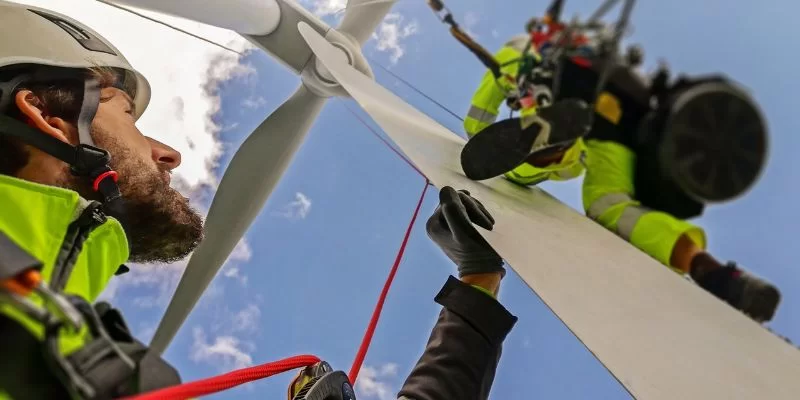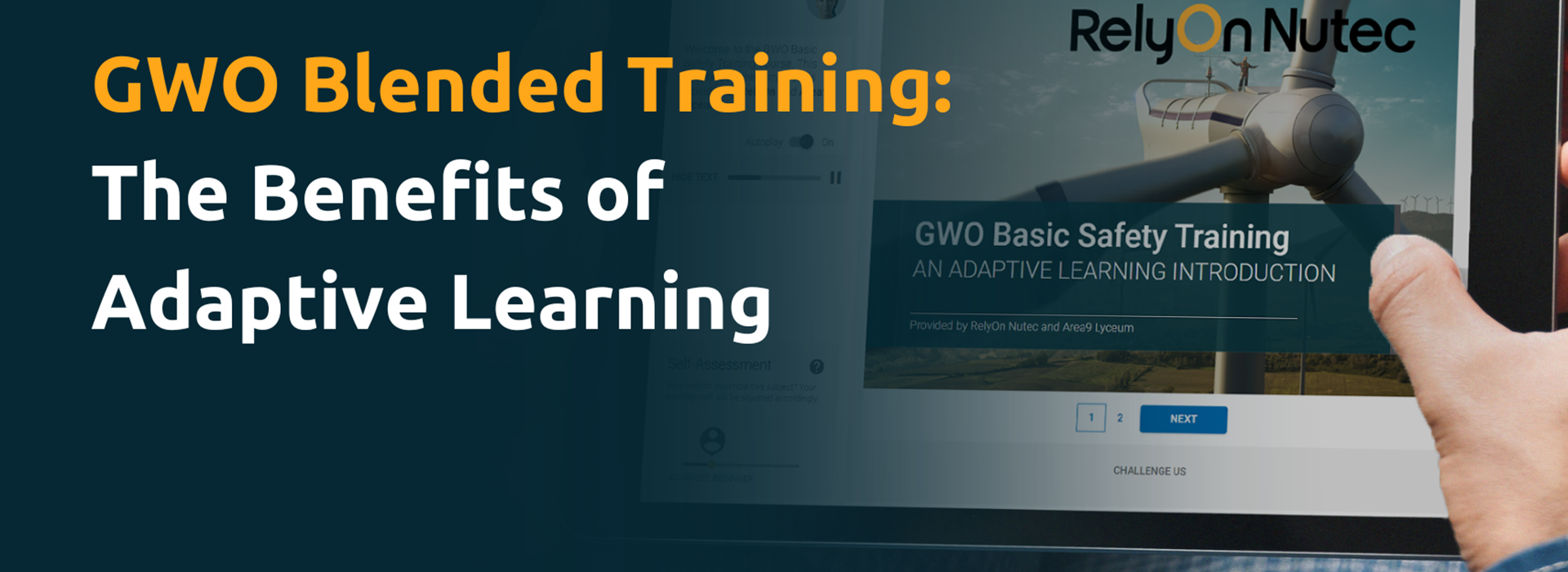Ok
Introduction
The forecast skill shortage, coupled with an acceleration of investments in the wind energy sector, put pressure on training capabilities of both the existing and future workforce, as well as training providers’ capacity to meet the growing demand. Additionally, with the demographics of the workforce undergoing a generational change, reviewing effective training practices and understanding the unique differences in how these groups consume information will be crucial. Today's education and training systems are not keeping up with the current demands for skills, let alone new directions the near future will bring. Thankfully, technological advances and continuous development have created new and efficient ways of training and educating workers. Combined, these advances will play a key role in preparing workforces for future jobs.
Blended and Adaptive Learning
Blended Learning
Blended learning is a refreshingly new form of training delivery where theoretical parts of a training course are taken online. Classroom teaching is transferred into an online course that participants take at their own pace, requiring only the practical, physical aptitude aspect to be taught in person. This makes it possible to decrease the total time needed to complete training courses. Looking at the GWO package, for example, time could be reduced from six to only three days. In addition to saving time, blended learning offers higher flexibility as it allows you to complete the theoretical part whenever it suits the learner best.
When we developed our GWO blended learning courses, both a digital team and topic (subject matter) experts were involved in the process. The digital learning experts bring a background in theoretically thinking about how to deliver content through digital platforms best, while the subject matter experts ensure that the content itself is accurate and relevant. As the GWO training courses were originally physical training courses, the starting point usually lies in the pre-existing content, which was then examined and broken down into concrete learning objectives. Once those objectives were developed, the digital team decided on the best way to deliver the necessary knowledge.
Adaptive Learning
Adaptive learning can evaluate the student’s skills, knowledge and confidence levels and, therefore, adapt to each individual’s personal needs - by combining theories of optimal learning with the capabilities of algorithms and computers. This reduces frustration during the learning process, optimizes learning outcomes and ensures that time is spent on the subjects that need the most attention. Adaptive learning, therefore, allows the learner to make mistakes and pursue misconceptions and can accordingly provide an optimal experience for the learner.

The adaptive learning approach relies on well-established concepts in educational psychology and cognitive science – augmented by usage and data points from real learners using the platform. Models gather data from learner interactions moment-by-moment and evolve to meet the unique needs of each learner. By combining the power of digital delivery with skilled educators’ human insights and judgements, adaptive learning technology can provide mastery learning and individualized programmes for learners at scale. Thanks to intelligently spaced repetitions and individualized learning speed, adaptive learning leads to higher retention and an optimized learning process.
Blended GWO Courses
The Global Wind Organisation (GWO), which sets common international standards for safety training and emergency procedures, was one of the first to open up its standards to blended teaching. As an official GWO training provider, we acted fast on the organization’s announcement in order to be one of the first providers in the market to offer blended GWO courses. Historically, this training was only available fully in person at an approved GWO training center - requiring each technician to source an approved facility and spend five days in a classroom plus travel days prior to and following the completion of training. Being a leader in global training services to the energy industry placed us in a unique position to understand these challenges, and in April 2020, we began our digital transformation and implemented the overall strategy that led to an industry-first, hybrid GWO-approved course.
We adopted a novel approach to digital learning, which was then applied to the GWO Basic Safety Training course by digitalizing the theory-based components of the curriculum facilitated by cutting-edge, adaptive learning technology. The online portion of the course personalizes the content delivery in real-time to keep each learner on the optimal learning path and highlights gaps in knowledge and self-assessment via advanced learning data analytics. The understanding of the content is strengthened through spaced repetitions and personalized refresher assignments, leading not just to mastery but also automaticity with an overall ambition to facilitate further reduction of serious incidents and reduce risk of errors across the energy sector - protecting people, assets and the environment.
Benefits of Blended GWO Training
GWO blended learning courses bring many benefits, two of the obvious ones being saving time and higher flexibility while providing higher proficiency at the same time. This also saves time and money, as traveling expenses as well as time away from the workplace decrease. Additionally, adaptive learning uncovers and fixes unconscious incompetence through smart technology and algorithms, i.e. it highlights areas where the learners think they know but in fact they do not yet master that content.

Furthermore, blended GWO courses can be more engaging and effective - with graphics, icons, and pictures, adaptive learning makes the course content easy to understand for everyone. In combination with algorithms adapting learning pace and repetitions to each individual learner, the GWO blended learning courses improve engagement and reduce frustration. Lastly, adaptive learning offers rich learning analytics, which can be used to further improve and optimize the learning process and support instructors to focus on the most challenging topics.
What we can offer you / how we can help
At RelyOn Nutec, we offer a global presence with over 30 locations worldwide. This means we are able to provide organizations with the same experience regardless of wherever in the world you go. Our different centers provide the same type of content to ensure high-quality training courses are offered in all parts of the world. In addition, we offer blended learning courses via an integrated digital learning platform instead of an external provider. Our in-house solution provides us with the unique possibility to constantly develop and improve our platform and the courses directly based on customer feedback. This chance to continuously redevelop and adjust makes it possible for us to offer first-class blended GWO training based on years of improvements and updates.
As of today, we offer a wide range of training related to the wind industry for entry-level all the way up to advanced training for seasoned industry professionals. Our courses are certified by GWO, which ensures that delegates can apply their skills and certificates working in the wind industry all over the world. In particular, we provide blended GWO-accredited Basic Safety Training (BST) consisting of the following:
- First aid
- Manual handling
- Working at heights
- Fire awareness
- Sea survival
Conclusion
In the future, investments in the wind sector are likely to grow even more extensively and lead to an accelerated growth of wind energies. To avoid problems caused by a lack of skilled and sufficiently trained personnel, it is important to act now and start retraining and upskilling workers. Thanks to recent technological developments, blended GWO courses revolutionize traditional training through higher flexibility, shorter training time, and improved learning outcomes. Blended GWO training, therefore, offers an optimal solution for the wind industry to battle skill shortages by educating new workers as well as retraining the already existing workforce.
Want to know more about how we can support the renewables industry? Take a look at our website, or get access to our latest webinar here.
Next read
-

Our Role in the Energy Transition
The importance of the energy transition is now greater than ever. We aim at supporting this development by training the next generation of workers for renewable energies.
Article 17. January 2023 -

RelyOn Nutec expands renewables training footprint
RelyOn Nutec is thrilled to announce the acquisition of one of UK's leaders in Health and Safety Training
Article 28. October 2022
